It has been a tumultuous year in data privacy to say the least – we’ve had a huge increase in data breaches, including some of the largest in history; an uncertain future when it comes to cybersecurity policies; new European regulations that have major implications for U.S. companies; and yet, business carries on. Despite all the challenges and risks, businesses will continue to move forward on digital transformation, cloud adoption and mobile adoption, all with an eye on cybersecurity.

Cloud adoption is now mainstream and businesses are continuing to invest heavily in moving operations to the cloud. In fact, over 65 percent of organizations are currently focusing on cloud adoption. Although security is a priority, IT departments are being pressured by the business to move at a pace of change impossible to achieve by changing existing systems alone. This pressure will see an increase in cloud technologies that provide significant improvements in customer interaction and improvements in retaining and servicing customers. Cloud services that drive business efficiency while ensuring security will lead the way in cloud adoption.
Digital transformation: a major revenue driver. Every major vertical will invest in digital transformation in 2017, if they haven’t already started to do so. Highly regulated industries in particular will make investments, including finance, healthcare and the life sciences, and will be led from the top down by CEOs and CMOs. However, this will cause major conflicts with the IT departments as they try to retroactively fit the new solutions with the legacy systems currently in place.
Mobile, mobile, mobile: Everything must be built for mobile, but security is still a top concern. Once the line between personal and businesses devices blurs, where does the responsibility lie in protecting data, the “crown jewels” of your organization? Many organizations have taken the approach of securing the device and the data held on that device. The bigger issue businesses are facing is how to protect the data once it leaves the device. The growing need to protect the data in motion, while collaborating with partners or third-party vendors, will see a rise in secure ecosystems or portals where cloud technologies will allow secure movement of data inside and outside the traditional enterprise boundaries.
Collaboration is moving up the security pyramid: Enterprise file sync and share (EFSS) and secure Workplace collaboration/chat apps are old hat, and fall at the bottom of the security pyramid. In 2017, collaboration initiatives will be driven by the need to protect the highest-value data and specialized digital processes (e.g. M&A due diligence, post-merger integration, clinical trial remote monitoring, and regulatory risk management). Consumer products struggle to fill this need, so expect more enterprise-grade services to appear.
Cybersecurity: not IF, but WHEN. Businesses are approaching cybersecurity with a whole new mentality in 2017, assuming that at some point they will experience a data breach, if they haven’t already. However, most companies can’t keep up with different threats from hackers, phishing, and cyberattacks, so cybersecurity collaboration initiatives will be driven by businesses resorting to protecting the most critical assets only. If 2016 was the year of the hack, then 2017 is when data breaches will go viral. With an inability to classify all data, IT departments will continue to classify and protect just the critical data.
Overall, 2016 has seen major changes in data privacy and the cloud, and a lot of 2017 will be dedicated to making sense of everything. Some of these trends are new, and some are well-known, but I look forward to exploring each one in more depth as they develop further in 2017.
By Daren Glenister





